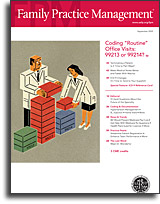
Fam Pract Manag. 2005;12(8):13

As Robert L. Edsall, FPM’s editor-in chief, mentioned in this space in our last issue, our editorial staff recently embarked on a re-visioning – a comprehensive analysis of the journal designed to produce changes that keep FPM fresh and relevant. This issue is the culmination of that effort. Messing with success is risky, but we’re always looking to improve our ability to help you be successful. Here’s what we’ve done:
We’ve thoroughly redesigned FPM, and we hope you’ll agree that the result is a cleaner, simpler layout that makes reading easier. Change is most obvious on the cover, which now features a comprehensive list of the issue’s articles identified by their full titles. We think “user-friendly” describes the design of the rest of the issue as well.
Of course there’s more to the re-visioning than giving FPM a fresh new look. Here are some of the other changes you can expect:
The content you used to read in our Getting Paid, Improving Patient Care and Computers departments will still appear in FPM, but in the form of feature articles.
You’ll see more Editorials, and they will address hot topics or provide article-related commentary. We hope you’ll share your opinions on these same subjects, starting with Dr. Doug Iliff’s “10 Hard Questions About the Future of the Specialty,” on page 14 in this issue.
The department formerly known as Monitor has become News & Trends. We will continue to devote this space to keeping you updated on current events and legislation that could affect your practice.
Ask FPM is now Practice Pearls, which includes experts’ answers to your practice management questions as well as tips drawn from the literature and from your experience. We’re counting on you to enrich this department with practice-tested advice – and we’ll even pay $25 for your best pearls.
The Last Word takes the space formerly occupied by Balancing Act on the last page of each issue. You will still find articles about maintaining life balance on this page (and in our feature pages), but you’ll also find essays that reflect on the highs and lows of practice and what it means to be a family physician today. We published this department in FPM’s early years and have resurrected it to provide a forum for more thought-provoking ideas. We hope you enjoy this month’s installment on page 68.
The new design makes Coding & Documentation and Quiz easier to read, but otherwise we didn’t change the substance of these two departments, which surveys and quiz card returns tell us are among your favorite parts of FPM.
In the feature articles, we plan to continue providing the practical, interesting and useful content you’ve come to expect from FPM. As you might have guessed from the nine pages of coding content in this issue, we’re strengthening our focus on coding and documentation. Over time you’ll also see more articles on high-quality patient care, information technology and meat-and-potatoes practice operations. Encounter forms, flow sheets and coding references will continue to be part of the mix; we want to equip you with the knowledge and the tools you need to practice better.
Some things haven’t changed at all. The FPM editorial staff, led by Bob Edsall, who for this issue is taking a well-deserved break from writing this column, continues to work hard to identify and meet your needs. And the resources of the AAFP continue to make the job easier. Our connection with the AAFP’s Commission on Practice Enhancement, the Center for Health Information Technology and the AAFP’s practice management e-mail discussion list helps us stay attuned to the issues that matter most to you, connects us with the experts whose knowledge is most useful to you and enables us to develop articles and tools to help you manage the problems you face.
We hope you will take a few minutes to check out the re-visioned FPM and share your comments with us by completing the survey inside the front cover. FPM is your journal; it should reflect your interests and serve you well.